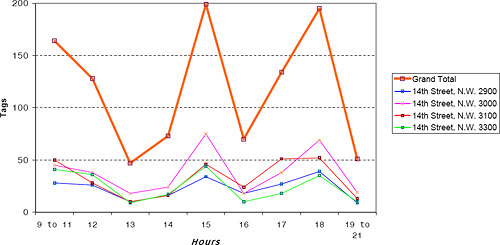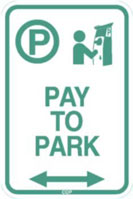DDOT to discuss Columbia Heights parking pilot tonight
This evening, officials from DDOT will discuss the performance parking pilot for Columbia Heights. The meeting starts at 6:30 pm, and it would help for residents knowledgeable about parking policy to go. The pilot zone has six blocks of parking controlled by multispace meters. Under the pilot, DDOT is monitoring occupancy rates, and is supposed to adjust the parking rates based on occupancy. As part of this project, DDOT produced a report (PDF) for the study area. The report clearly discusses the purpose of performance parking, and emphasizes the point that convenient curbside parking is important. Citing Donald Shoup, it emphasizes that people don’t go to an area to park, but rather to shop, eat, go to parks, see residents and so on, and therefore parking policy shouldn’t revolve around parking per se, but on making it easier for people to visit. Overall, the report does a good job informing policymakers and the public about the parking conditions observed in Columbia Heights. It ends up making the right recommendations for most blocks of the study area, but gets a few key conclusions wrong. This article explains the study and its conclusions; in a second part this afternoon, I’ll outline the areas where I disagree with DDOT’s recommendations.

Vehicle tags observed per hour on multispace meter spaces on the
2900-3300 blocks of 14th Street, NW in the summer of 2009.
DDOT contracted with Council of Governments to collect parking occupancy and turnover data for the study zone. COG used a car equipped with cameras and a GPS unit to log the location and time of observed license plates, while periodically driving a pre-determined route.
The report contains some interesting nuggets:
- Parking was very crowded at the multispace meters, indicating over 85% average occupancy at three of them, and over 100% maximum occupancy at all of them. Since occupancy was determined by comparing the number of cars parked to the number of average sized cars that could be parked legally, smaller cars or tighter parking could result in occupancy above 100%. In fact, COG reported that one meter had 190% occupancy at one time.
- Turnover at meters was average. Assuming they paid for their parking, on average people parked about two hours and paid $4. This is higher than the charge for the DCUSA garage, indicating perhaps that they either value the convenience of on-street parking or don’t know about the DCUSA garage.
- The meters have almost paid for themselves in a little over a year. The meters cost $7,140 each, or $107,100 for the performance parking zone. By law, 60% of the meter revenue at first pays back the meter cost, and after 7 months, DDOT has allocated $49,904 to pay for the meters. Once the meters are paid for, 75% of the revenue will be devoted to the local area for improvements. (In the ballpark zone, with higher rates, DDOT is closer to paying off the meters.
- 42% of plates were registered in DC, 16% Virginia, 8% Maryland, and 34% other or unknown. The high other/unknown number could either mean people aren’t registering their cars in the District, or as the report suggested, could just be a problem with identifying the correct state. Perhaps DDOT could have COG separate this next time into “Other” and “not identified” plates?
In the report, DDOT states that three out of the six multispace meter blocks have occupancy rates above 85%, and recommends increasing the meter fees as soon as the 14th Street streetscape project is complete. It’s unclear whether DDOT means to increase all of the meter fees all of the time, or whether the fee increases will be targeted only to peak times and locations. Still, it’s clear that DDOT is making the right policy choice to react to high occupancy rates with higher fees. That’s the way performance parking is supposed to work.
However, the report is missing some detail that would allow finer and more helpful adjustments of parking meters. Next, I’ll analyze that issue.

